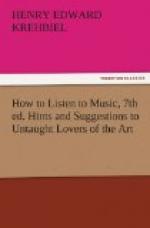[Sidenote: Defects of the pianoforte.]
[Sidenote: Lack of sustaining power.]
This is one side of the picture and serves to show why the pianoforte is the most universal, useful, and necessary of all musical instruments. The other side shows its deficiencies, which must also be known if one is to appreciate rightly the many things he is called upon to note while listening intelligently to pianoforte music. Despite all the skill, learning, and ingenuity which have been spent on its perfection, the pianoforte can be made only feebly to approximate that sustained style of musical utterance which is the soul of melody, and finds its loftiest exemplification in singing. To give out a melody perfectly, presupposes the capacity to sustain tones without loss in power or quality, to bind them together at will, and sometimes to intensify their dynamic or expressive force while they sound. The tone of the pianoforte, being produced by a blow, begins to die the moment it is created. The history of the instrument’s mechanism, and also of its technical manipulation, is the history of an effort to reduce this shortcoming to a minimum. It has always conditioned the character of the music composed for the instrument, and if we were not in danger of being led into too wide an excursion, it would be profitable to trace the parallelism which is disclosed by the mechanical evolution of the instrument, and the technical and spiritual evolution of the music composed for it. A few points will be touched upon presently, when the intellectual activity invited by a recital is brought under consideration.
[Sidenote: The percussive element.]
[Sidenote: Melody with drum-beats.]
[Sidenote: Rhythmical accentuation.]
[Sidenote: A universal substitute.]




